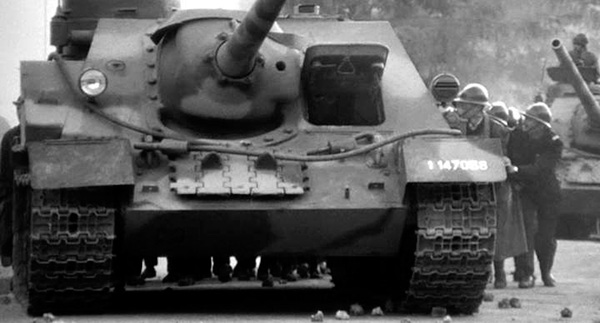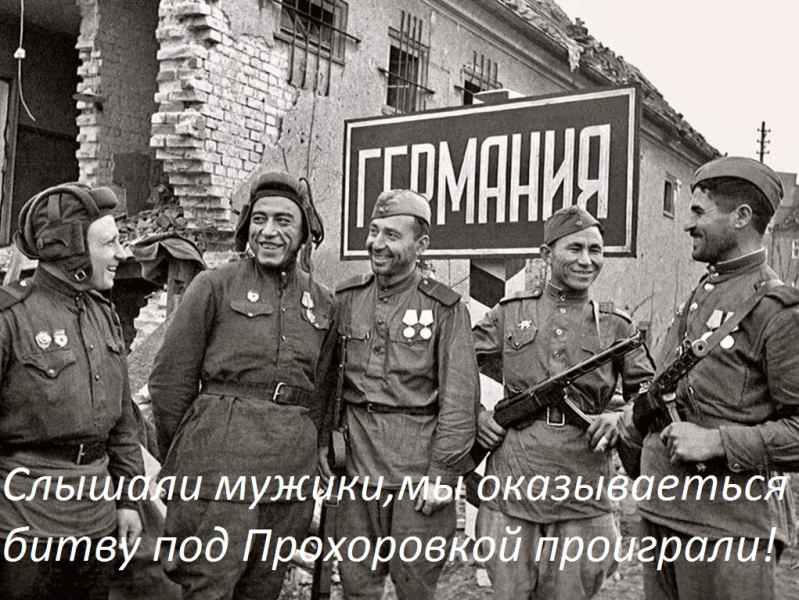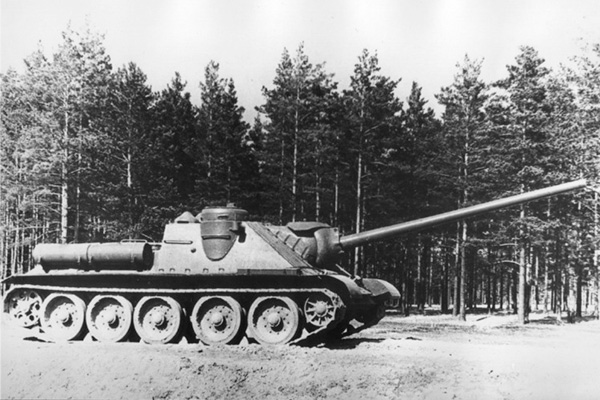
Structurally, the average anti-self-propelled gun SU-100 was in many ways similar to the earlier Su-85. The main differences between the two cars touched only in the type of artillery systems and related improvements her body. Chassis SU-100, completely borrowed from the SU-85, It included the following components (as applied to one side):
– five rollers diameter 830 mm with rubber tires and individual spring suspension;
– front idler, cast, a crank mechanism caterpillars tension;
– rear wheel drive with six rollers for engagement with ridges Track Shoe;
– caterpillar consisted of 72 cast steel shoe width 500 mm increments 172 mm (36 with a comb and 36 without crest), the total mass of caterpillars – 1150 kg.
SAU SU-100 – video
Due to the increased mass of the suspension springs thickness increased with 30 to 34 mm. In other respects the chassis components have not changed and are fully interchangeable with the T-34 and SU-85 self-propelled guns. The housing has welded and assembled from sheets of rolled steel armor. Structurally, it consists of the bottom, fore and aft, sides, crew compartment roof and the roof of the engine compartment. Reservations self-propelled guns were differentiated. The bow of the hull had a wedge shape and is formed by two angled armor plate. Upper thickness broneliste 75 mm was placed at an angle of 50 °. It offset to starboard cutout was made under installation tools, On the left is the door closed by an armored cover with two viewing devices. Lower frontal armor plate had a thickness 45 mm and was set at an angle of 55 °. To him it is welded two towing hook.
Cutting boards and food also had a slight tilt, but limited to the thickness of armor 45 mm. There is also fastened landing handrails, Brackets external tanks and Bonki mounting parts and accessories. Located along the boards nadgusenichnye shelves, ending mud "wings". On the shelves were installed spare parts boxes, one at the left front and rear right. Roof crew compartment was made of a single sheet of thick armor 20 wherein mounted mm: stopper cap gun, two-folding panorama sunroof, two-folding boarding hatch (L-shaped), commander's cupola, exhaust fan with a spherical armored covers. The lower body portion, made of armor plate thickness 20 mm, there were holes for mounting brackets of rollers, tension and the drive wheels. To the aft armor plate was welded casing final drive.
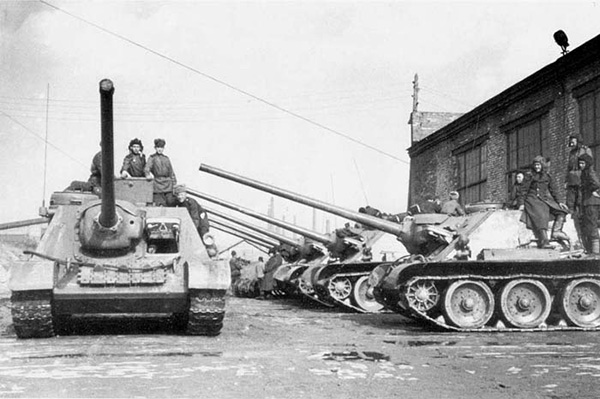
Engine-transmission compartment SU-100 was protected by an armored box, consisting of two feed bronelistov thickness 45 mm, two inclined board and three upper bronelistov. Although the thickness of the sheets of ITO-board crew compartment was similar their installation angle has been increased. cutouts are made in the upper lateral longitudinal broneliste for three shutters and hatches, intended for access to the oil tank and the suspension shafts and the fourth and fifth rollers. Top side plates bronekolpzkami closed convex grids with the air passage for shutters. Transmission compartment had a convex flap of the cover sheet metal with five windows, screened. The lower aft side armor plates were mounted gear housings, Two towing hook and two upper folding leaf hinge. The upper armor plates was soft and had in the center of the hatch cover, and on each side were made cuts with armored covers for the exhaust pipes.
bottom of the hull was "dialer" and going from four sheets thick armor 20 mm, joined by weld seams with reinforced linings. In the middle of the bottom right side of the escape hatch was made (cover opened down-right). Self-propelled gun was equipped with the same engine, as its predecessors. The MTO sets the 12-cylinder, 4-stroke diesel beskompressorny B 2-34 wattage 450 HP. at 1700 obmin. The operational power was 400 HP. at 1700 obmin., maximum - 500 HP. at 1800 obmin. To clean air enters the cylinder of the engine air cleaner used "multicyclone". Starting the engine could made the electric power PT-700 15 HP. or compressed air, for which there were two balloon in the department of management. Typically, B-2-34 was used diesel DT, but also allows the use of gas oil brand "E" according to OST 8842. The basic fuel capacity is 400-liter fuel tank, placed in the rear of the hull. Fuel is supplied to the engine by a pump NK-1. On the sides of the MTO could be mounted 95-liter replacement fuel tanks. The lubrication system has a circulation and a pressure of three-section gear oil pump. Oil tanks capacity was 80 liters. Coolant - Liquid, closed, forced circulation. On either side of the engine mounted two tubular radiator capacity 95 liters inclined toward him.
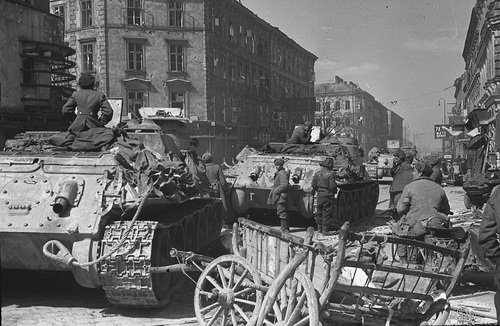
Transmission SU-100 did not differ from the self-propelled tank and consisted of the multiplate clutch master dry friction, Manual 5-speed gearbox (with constant mesh gears), multiple-disc steering clutches, single-stage final drive and the floating band brake.
Electrical equipment was performed by odnoprivodnoy circuit with mains voltage 12 and 24B. It consists of a generator GT-4563A power 1 kW and four batteries 6-STE-128 capacity 128 Ah each. For consumers of electric power starter treated with CT-700 starter relay for starting the engine, Two CF-12 motor-fan, provide ventilation of the crew compartment, devices external and internal illumination, 4-SH signal to the outer chime, electric shock gun descent mechanism, heater safety glass sight, igniter smoke grenades, and internal radio communication device, Telephone communication between crew members. On the SU-100 early releases established shortwave transceiver simplex transceiver 9 or 9 RS-RM, enables communication at distances up to 25 km. For communication between crew members use the internal intercom TPU-3-bis-F.
SU-100 Armament consisted of a 100 mm cannon D-10C Sample 1944 year with a barrel 56 calibres. Total weight was 1435 kg. The gun had horizontal guidance angles within 16 ° from the vertical and -3 ° to + 20 °. Maximum length of the rollback in the shot does not exceed 570 mm. The main trigger was electric, but there was also a mechanical manual. Complete with a gun D-10S installed articulated telescopic sight TS-19 (direct fire), as well as the level of the lateral view and (firing from covered positions). Practical rate of gun 5-6 rounds per minute.
The gun was mounted in a cutout frontal armor plate and protects the fixed Reservations complex shape, which is attached to the body by bolts. Outside installation is protected by a movable gun armored spherical mask.
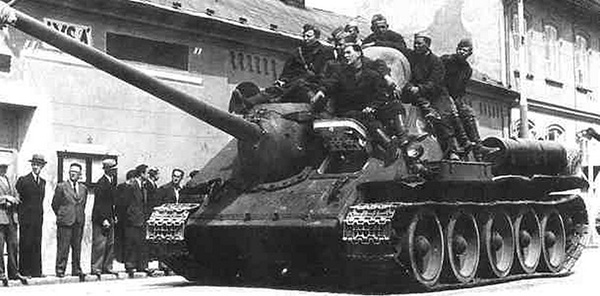
Ammunition consisted of guns 33 shots, placed on the shelves at the back of (8) and the port side (17) the crew compartment, as well as on the floor right (8). Nomenclature of ammunition for the D-10S was very broad, especially closer to the stake of the war. Its structure includes six types of shots:
UBR-412 - a unitary cartridge with armor-piercing tracer projectile ostrogolovym BR-412 and fuse MD-8
UBR-412B - a unitary cartridge with armor-piercing tracer projectile jughead BR-412B and fuse MD-8
RO-412 - a unitary cartridge with a fragmentation grenade Marine O-412 and fuse RGM
UOF-412 - a unitary cartridge with high-explosive fragmentation grenade OF-412 and fuse RGM
UOF-412U - unitary cartridge with high-explosive fragmentation grenade PF-412 with a reduced charge and fuse DDM
UD-412 - a unitary mass of smoke shot 30,1 kg with fuses DDM, RGM-6, B-429
CA-412U - unitary smoke shot weight 30,1 kg fuse with B-429
UBR-421D - a unitary cartridge with armor-piercing tracer projectile with a ballistic armor-piercing tip BR-412D
UBK9 - unitary cartridge with the cumulative projectile BK5M
Unitary cartridge with armor-piercing discarding sabot projectile.
The last three types of projectiles appeared in the SU-100 ammunition only after the war, so after 1945 , the standard equipment included 16 high-explosive, 10 armor and 7 cumulative shots. In this way, self-propelled gun SU-100 is a large multi-purpose assault gun, than specialized anti-tank weapons.
In addition, in the fighting compartment fit into two 7.62-mm submachine gun with ammunition PCA 1420 rounds (20 CDs), 4 anti-tank grenades and 24 Hand grenade F-1. To put a smokescreen on the battlefield at the rear of the vehicle to install two smoke bombs MDSH, which produced ignition charged by the inclusion of two toggle switches on the dashboard MDSH, mounted on the motor bulkhead.
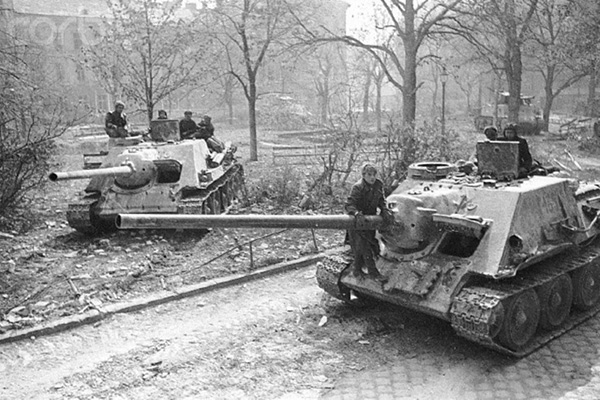
Observation devices were few, but very well placed on the case of self-propelled. The driver in the stowed position was driving with an open hatch, and combat the use of optical inspection equipment with armor covers. The commander's cupola, was situated on the starboard side, There were five observation targets with bulletproof. Roof mounted surveillance device MK-4.
Standard color of the SU-100 has a protective green for all surfaces. On the sides of the conning tower of white paint is applied to the three-digit numbers and identification marks of the. In winter, the self-propelled guns were painted with white paint easy washing. Sometimes on the roof and the sides of the cabin could be labeled for identification from the air. It could be circles and stripes, but in one of the cases involved the use of white crosses. Permitted on the board application of inscriptions and slogans, eg: "Soviet miner", "For Rodin" etc.
Combat use ACS 100 Su Hungary
The first major battle in the path of a long battle SU-100 was the operation to destroy the enemy troops in the Budapest area. later the shadow 1944 , Soviet troops managed to block the city, but it is in a "ring" of German-Hungarian group was very strong. Had to transfer reserves - in December at the disposal of the command of the 3rd Ukrainian Front arrived 1st Guards Tank Corps I.N.Russiyanova. curious, that the unit has been created from the remains of part of the 100th Infantry Division (!), virtually alone defending Minsk three years earlier. During this time, the body several times to re-form and ebbed before being sent to Hungary was very patchy structure. Connection Russiyanova got a relatively new T-34, and "worn" M4A2 "Sherman", transferred from other departments. To strengthen the housing in its composition introduced just three self-propelled artillery regiment equipped 59 latest SU-100. Disembark on the east bank of the Danube gunners command instructed to conduct an offensive in the area of Bicske, until the enemy had time to gain a foothold there. During 4 January crews of three SU-100 regiments and infantry outflanked 93rd Infantry Division and the Germans rushed to the rear of the enemy. Settlement was occupied by Soviet troops, who went on the defensive in anticipation of counterattack. Since its direction remains unknown forces regiments strongly stretched along the front. By the morning of January 6, two regiments of the Su-100 passed under the operational control of the 18th TC, heavily damaged in the recent fighting near the village Bajina. Baptism of fire "hundred" was held on January 7th at Zsámbék.
On this day, the Germans were able to push the defense of the 49th Infantry Division, compounds which began to retreat. Left alone with the enemy crews 382 th glanders have been forced to fight by all available means. The German offensive was halted a high price - it was destroyed 9 and knocked out more 2 self-propelled.
However, the most fierce battle, vylivsheesya in counter tank battle, It broke out on January 9, at atone. Received the order to counterattack the enemy of the 1st Guards. Brigade ran into a strong antitank defenses. Around noon near Gyula Germans entered the battle large tank, which led to a mutual large losses - for the day crew lost 18 tanks (mainly "Sherman") and more 600 personnel of the.
Next 382 th regiment was transferred to the 21 th Infantry Division and participated in the defense of Szekesfehervar, and self-propelled guns of the 1st gv.brigady, consisting of two batteries, sent to Barachke and Felshe-Belsch. It is here that the guards were attacked by tank formations divisions SS "Viking" and "Totenkompf". The enemy in the SU-100 was more than decent - besides various StuG and Pz.IV Germans entered the battle heavy tanks Pz.VI "Tiger" and Pz.VI "Konigtiger". The enemy was able to drive a "wedge" in the order of two cavalry divisions, virtually had no tanks, and fight your way to the Barachke. On the morning of January 24, the Wehrmacht moved into a general offensive with the participation of three armored divisions IV Corps, but without success, and in this attack fizzled.
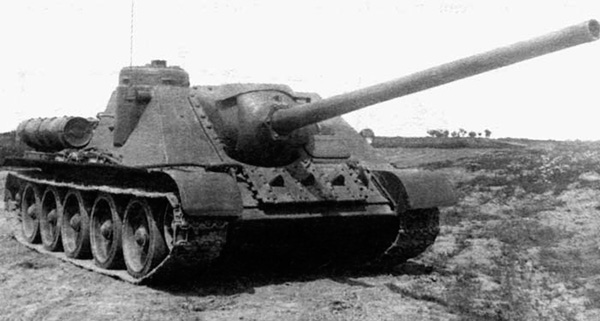
Total, since 19 by 25 January (during the operation "Conrad II") 1-I Guards Mechanized Corps lost 54 "American" and 17 SU-100. Start the "hundredth" would look like not so rosy, but we must not forget, that in some cases self-propelled guns were used as assault weapons and acted without the support of infantry and tanks.
In connection with the worsening situation front commander 25 introduced in January last reserves into battle, including the 145th glanders equipped with SU-100. Front managed to stabilize 30 January, and then began the rout of the remaining enemy forces. Budapest Sturm completed 15 February, when the remnants of mining IX Corps SS went on break and were even able to achieve some success. true, of 28.000 German and Hungarian soldiers to their managed to get around 800. but, Battle of the Hungarian soil did not end.
To defeat the remaining German-Hungarian forces of the Soviet command planned operation and the Lake Balaton. Although the armored forces of the Red Army also suffered severe loss of their potential impact was still strong. When conducting operations Balaton distinguished 207-I, 208-I and I-209 self-propelled artillery brigade, which until then were considered in reserve. TO 10 March total SU-100 was already 188 machinery net loss.
Defensive battle developed successfully for the Soviet troops, but both sides suffered heavy losses. The command of the 28th Army was forced to throw on the cutting edge of the front 208 Brigade, transferring it to the subordination of the 135th Rifle Corps, but this measure is clearly too late. Self-propelled guns were ordered to be put forward this morning 9 March two shelves in the area Nadherchek - Deg, and a third regiment left in the army reserve in the ball area. Preparing to march almost not conducted, so the Tsetse highway – Székesfehérvár 1068 th Regiment came under attack had broken through the German tanks and lost 14 of 21 SPG.
In a similar situation months later it turned out to be another regiment fought in Slovakia. It is now widely known post-war picture with three burnt SU-100 on the road at Brno. All self-propelled guns were hit by fire only German tank destroyer, shoot from ambush. This proves once again, that even the defeated enemy should not have to dismiss and to march to conduct exploration cost. On the other hand, Reservations SU-100 is clearly not withstand fire from 75-mm and 88-mm anti-tank guns.
To make up for this loss did not succeed. all in all,, for 8-9 Martha, 208-Brigade hit and destroyed 14 enemy tanks and self-propelled guns, and 33 armored vehicles. Own combat losses amounted to 12 SPG, 8 of burnt.
During March 10, reflecting counterattack the enemy, it caused considerable damage to the crews of 1951 and 1953, the regiments. So, SU-100 under the battery commander Senior Lieutenant A.Kochergi, as well as combat vehicles and junior lieutenants Vorozhbitskogo Samarin, was hit and burned three German tanks and self-propelled guns. On another part of the front battery 1952, the regiment under the command of Captain Vasilyev damaged three "royal tiger" without suffering own losses.
On the same day 1953rd Regiment was transferred to the 5th Cavalry Corps and given the task to organize an ambush and destroy the German troops, try to break out of the encirclement near Simontornya. Disguised their vehicles in the forest, through which the Germans were preparing to attack, crews organized hidden gun emplacements. morning 11 March attack came 14 German tanks, including heavy. At a signal from the ACS entered the positions and opened fire from a distance 1500 m. Despite the great distance once the Germans lost three tanks and had to stop the attack.
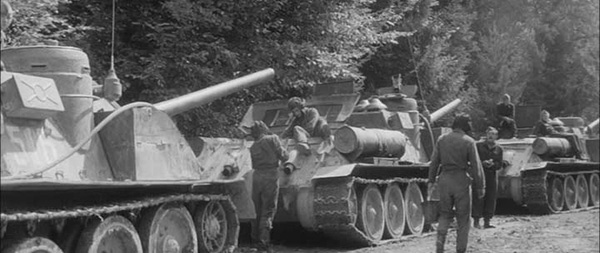
Actions self-propelled crews deserve the highest praise, However, in view of heavy losses in tanks, Revenues by the end of the operation to the Balaton 50-70%, during 11-12 Battery March SU-100 was used for non-core destinations - direct support of infantry. The result was quite expected and led to the loss of several tens of machines, most of which are not subject to restoration. Suffice it to say, that the 208th sabr, as of 5 Martha, was 63 "Weave", but to 16 March, their number decreased to 23.
The main outcome of the battle in Hungary was the consolidation of ambushes practice, the implementation of which began in 1944 by using the SU-85. Usually, battery "hundred" camouflaged in the woods or on the back slopes of the mountains, and firing positions were held in 100-200 meters ahead. Nearby was equipped with an observation post, which was officer commander and SU-76 and T-34. When the enemy self-propelled guns took a few shots and went to shelters, not allowing the opponent to find yourself. When, if among the attackers raised panic, "Shooting" was conducted on. Usually, the SU-100 opened fire from a distance 1000-1300 m, wherein the projectiles fired from guns D-10C are often covered with a goal from the first. For medium Pz.IV type tanks it ended with the partial destruction of the body, and in the armor of "Panther" and "Tiger" there were big breaks.
In a report on the fighting in defensive battles near Budapest noted, that the self-propelled gun SU-100, at slightly higher dimensions, have a significant advantage over the SU-85 for firepower. Although the rate of D-10C in combat conditions was 3-4 shots per minute (5-6 in rifle D-5S-85) Round weight significantly compensate for this lag. It was also noted, that "the frontal part of the SU-100 for light and medium artillery invulnerable, heavy-caliber artillery tanks and 88-mm frontal armor insufficient, very fragile ". Among the shortcomings complaints received in tight address pointing mechanisms of the gun and greater vulnerability sights. Besides, It expressed a wish to equip SU-100 machine guns, as it has done on the heavy ISU-152. The final report stated, that the 100-mm self-propelled guns are "the most effective means of combating heavy enemy tanks".
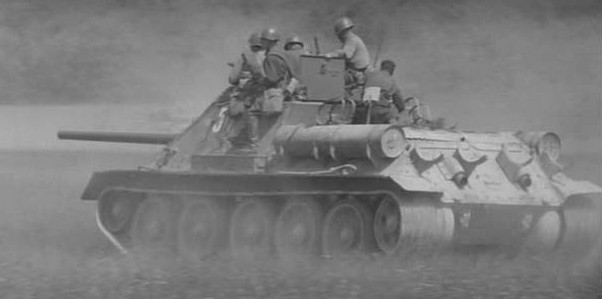
Tactic-technical characteristics SAU Su-100
| Crew, people. | 4 |
| combat weight, t | 31,6 |
| Length, m | 9,45 |
| Width, m | 3 |
| Height, m | 2,24 |
| weaponry | 100-mm gun D-10S |
| ammunition | 33 shot |
| Engine | The power-2-34M 520 HP. |
| full speed, kmh | 50 |
| Power reserve, km | 310 |
| booking | mask guns – 110 mm cutting his forehead – 75 mm housing forehead - 45 mm body board – 45 mm housing feed – 40 mm bottom – 15 mm roof – 20 mm |
| sighting devices | 10T-15 telescopic sight panoramic sight |
| Means of communication | station 9 RS, interphone 3F device TPU-bis, tankofon |
Photos ACS SU-100 Syria destroyed by Israel Air Force Army
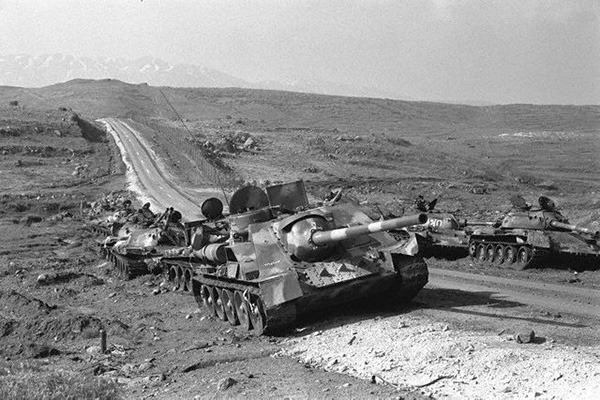
Egyptian ACS SU-100 captured by the British
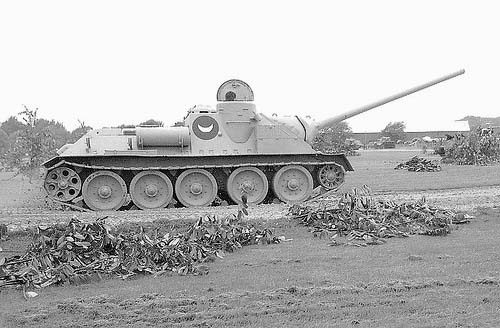
SAU Su-100 Algerian army
